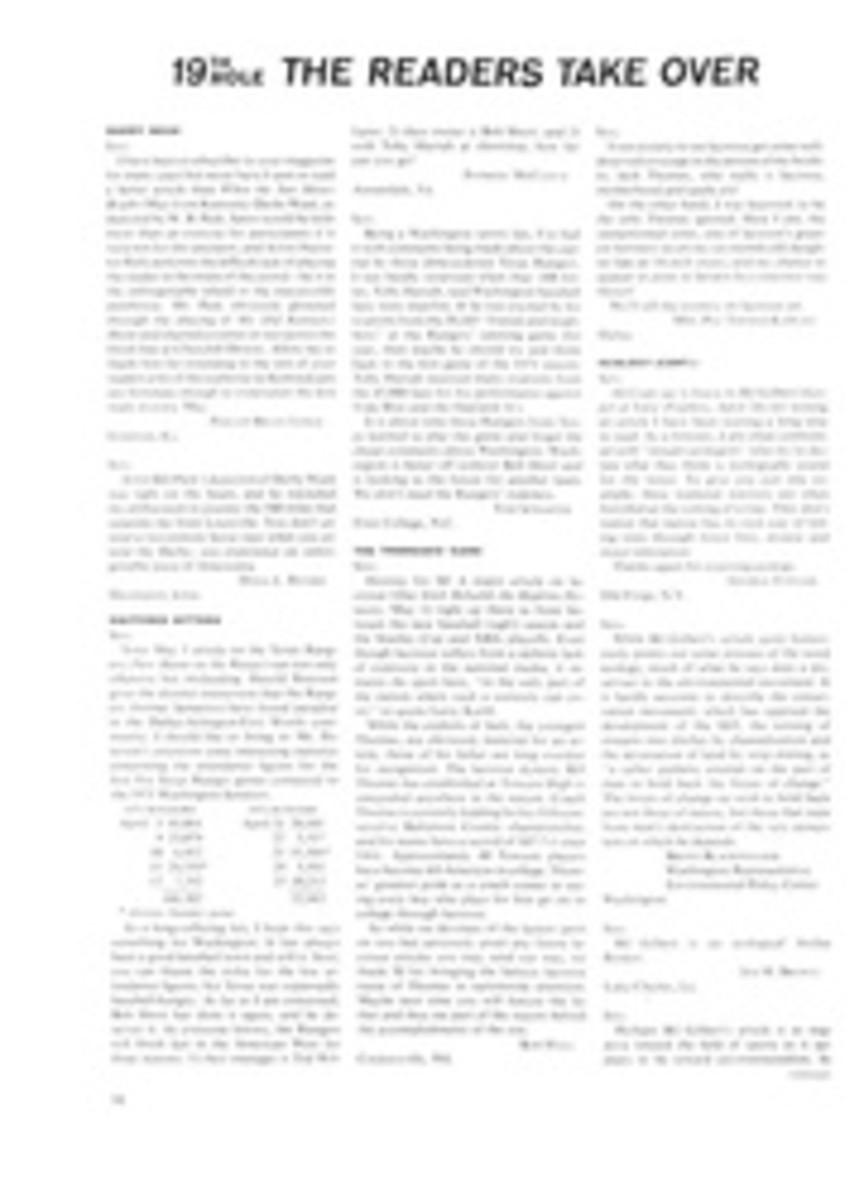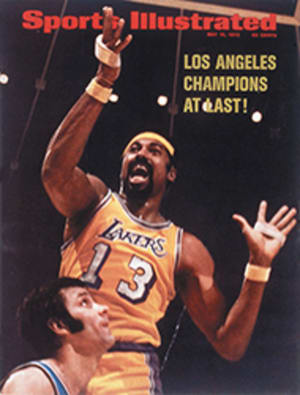
Hooton is doing his thang
The trick pitch is as old as baseball itself. Consider such honored deceits as the emery ball, the fadeaway, the sinker, the screwball, the spitter, the knuckler, the fork ball, the palm ball, the Vaseline ball and the blooper or eephus ball, to recall only the most obvious of the genre.
Indeed, for those pitchers not armed with such orthodox weaponry as the blazing fastball and the sharp-breaking curve, a little guile is essential to survival. Whitey Ford, for example, has confessed that in the final stages of his career, when he could no longer throw with his accustomed gusto, he was not above flinging an occasional "mud ball"—a baseball liberally smeared with the damp soil of the Yankee Stadium pitcher's mound.
But for all of the energy expended on such treachery, very little important new work is being accomplished in the field. Or as Chicago Cub Coach Pete Reiser has observed, "They've got a lot of names for these pitches now, but there are only so many ways you can throw a baseball."
And yet Reiser would exclude from his generalization the "knuckle curve" thrown by young Burt Hooton of his own pitching staff. "I imagine somebody must have had a pitch like this sometime, somewhere," says Reiser, searching back over more than 30 years of baseball memories, "but I can't think of anybody."
Hooton's pitching colleague Steve Hamilton is even more emphatic: "If anyone says he knows of somebody who throws one, he's full of bull." Cub Manager Leo Durocher, who is nearing his 50th year in the game, says, "I have never known of anyone who has thrown a knuckle curve like this."
What then is this unnatural phenomenon? Hooton is protectively vague in describing it, preferring, like any true artist, not to intellectualize his skills. "it's just a pitch," he will say with a shrug of his heavy shoulders, "and it's mine." But he will freely demonstrate the grip—ball held in conventional knuckler fashion with fingernails flat against the surface—and the over-the-top delivery. The trick is in the release.
"A knuckleball pitcher will push the ball out with his fingers," says Cub Pitching Coach Larry Jansen. "Hooton snaps his ball out, putting downspin on it."
A knuckleball floats lazily to the plate, but Hooton's downspinning knuckle curve fairly hums home. It is thrown with a fastball motion and it arrives quicker than any ordinary curveball. At the plate, the ball abruptly shoots downward, sometimes straight down, sometimes in or out, but always down. The catcher knows roughly where it is headed; the batter, possibly expecting a high fastball, finds himself the straight man in a disappearing act.
"If you didn't know better," says Durocher, "you'd swear the kid was throwing a spitter."
But the ball Hooton throws is as dry as the ink on the "substantial" contract he signed last June straight off the University of Texas campus. In Southwest scholastic circles the knuckle curve was known unaffectionately as "the thang," a sort of horrible science-fiction mutation. With it, Hooton compiled a 35-3 record and an earned run average of 1.14 in three years of All-America pitching. But he merely refined the pitch in college; he had been throwing it since, at age 14, he abandoned all hope of perfecting a real knuckleball and settled for this aberration.
Hooton and the thang had a 3‚Öì-inning fling with the Cubs in June 1971; then it was off to Tacoma of the Pacific Coast League for steady work. The knuckle curve fairly devoured hitters there. In one game Hooton tied a league record of 66 years by striking out 19 batters. Overall, in 102 innings, he struck out 135 and had an ERA of 1.68. He returned to the Cubs on September 6, and nine days later he struck out 15 Mets in winning a three-hitter. A week later he shut out the Mets again, this time on a two-hitter. In 21 big-league innings last year he had 22 strikeouts, two wins, no losses and an ERA of 2.14.
All this was merely preparation for his first start of this season, when he pitched a no-hitter against the Phillies—the first by a National League rookie in 60 years. It was Hooton's fourth major league start. In his next appearance he struck out nine Mets in seven innings before losing to Tom Seaver, who needed a shutout to beat him. Hooton has not quite approached those lofty standards in subsequent starts this year—who could?—but he has made a reputation for himself and his curious pitch.
Still, one pitch does not a pitcher make. And Hooton really does have another one, a "way above average fast-hall." according to Durocher, that prevents hitters from anticipating the knuckle curve. Durocher insists that Hooton throws harder than anyone on his staff, with the possible exception of Ferguson Jenkins on his good days. The problem, says Cub Catcher Randy Hundley, is convincing Hooton that he can get hitters out with his fastball. Hundley admits, however, that after the Cubs were safely in the lead during the no-hitter, he called for the knuckle curve 80% of the time.
What Hooton would seem to require more than confidence in his second pitch is a third one. He made a tentative effort in college to develop a slider, and Jansen worked with him on the pitch this spring until Hooton complained of arm pains. Hooton is not conditioned to throw conventional breaking pitches, which place greater strain on the arm than the knuckle curve. So the slider was abandoned for the time being. Instead, a changeup has been tried. It is Durocher's contention that this off-speed pitch could be doubly effective because Hooton puts so much zing into everything else he throws. But Hooton has been reluctant to throw the changeup, and Hundley has had to prod him. "It's hard to sell a kid on a new pitch," says Jansen philosophically.
Hooton is aware that his repertoire is not extensive and he is willing to add new numbers, but in the meantime he prefers his reliable standbys. "I ain't worried," he says calmly. "Yet."
One of Hooton's assets is his astonishing maturity. At 22 his manner, even with his elders, is almost avuncular. Talking to Hooton one half expects to be patted on the head or invited to climb aboard a knee. Durocher admires his coolness. As Leo has often said—and as he should surely know—"When you lose your head, you lose your behind."
Hooton is not likely to lose either one. When scrawny Bud Harrelson of the Mets beat him in Shea Stadium recently with a blooper to left field, Hooton's inner tranquillity was undisturbed. Hitters like Harrelson, he concluded, will do this because they merely punch out at the ball, like a child swatting a balloon. "Anybody can do that," he said. "If you hit the ball often enough, it will drop in."
Despite his college boy's face and curly blond locks, which are thinning a bit on top, Hooton thus seems much older than his tender years. At least he thinks older. Reading his fan mail in the clubhouse one day with an expression of tolerant amusement, he came upon a request for an autographed picture from an 18-year-old girl.
"Maybe," a visitor offered, "you should ask her for an autographed picture in return."
Hooton looked shocked. "You're kidding." he said, his tone suggesting that the visitor had taken him for someone else. "Why, she's only a kid."
It is small comfort to National League batters that Burt Hooton, for all of his elder statesman airs, is also just a kid and that he and the thang will probably be around quite a spell.
TWO ILLUSTRATIONS
DON MOSS
THE "DRY SPITBALL"
The grip Hooton uses is the standard one for knuckleballers—with the nails of the forefingers invariably flat against the seam—but his release is different. Instead of "pushing" the ball toward the plate he snaps it out with near-fastball speed, applying sharp downspin as he does so. While the knuckleball, which is much slower, may veer in any direction, the knuckle curve always breaks downward, like a spitball. Since Hooton also has a good fastball and throws every pitch with an over-the-top delivery, the knuckle curve is extremely deceptive.

